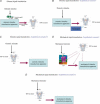TRPV4 plays an evolutionary conserved role in the transduction of osmotic and mechanical stimuli in live animals
- PMID: 15961428
- PMCID: PMC1474158
- DOI: 10.1113/jphysiol.2005.088963
TRPV4 plays an evolutionary conserved role in the transduction of osmotic and mechanical stimuli in live animals
Abstract
The TRPV4 ion channel, previously named vanilloid receptor-related osmotically activated channel (VR-OAC), functions in vivo in the transduction of osmotic and mechanical stimuli. In trpv4 null mice, TRPV4 was found to be necessary for the maintenance of systemic osmotic equilibrium, and for normal thresholds in response to noxious mechanical stimuli. In a Caenorhabditis elegans TRPV mutant transgenic for mammalian TRPV4, the mammalian transgene was directing the osmotic and mechanical avoidance response in the context of the ASH 'nociceptive' neurone. Molecular mechanisms of gating of TRPV4 in vivo are not known at this point and have to be determined.
Figures

References
-
- Albers MA, Bradley TJ. Osmotic regulation in adult Drosophila melanogaster during dehydration and rehydration. J Exp Biol. 2004;207:2313–2321. - PubMed
-
- Bargmann CI, Kaplan JM. Signal transduction in the Caenorhabditis elegans nervous system. Annu Rev Neurosci. 1998;21:279–308. - PubMed
-
- Bourque CW, Oliet SH. Osmoreceptors in the central nervous system. Annu Rev Physiol. 1997;59:601–619. - PubMed
-
- Bourque CW, Renaud LP. A perfused in vitro preparation of hypothalamus for electrophysiological studies on neurosecretory neurons. J Neurosci Meth. 1983;7:203–214. - PubMed
-
- Brewster JL, De Valoir T, Dwyer ND, Winter E, Gustin MC. An osmosensing signal transduction pathway in yeast. Science. 1993;259:1760–1763. - PubMed
Publication types
MeSH terms
Substances
LinkOut - more resources
Full Text Sources
Research Materials
Miscellaneous

